The 2008 RM-Z450 proudly stood in the corner of a community center conference room. From a few yards in front of it, as Suzuki's press representatives, Japanese engineers and PR gurus encircled me with greetings and salutations, I could almost hear it apologize.I think the big yellow guy was truly regretful for being late to the 450 game. To make up for it, his friends in attendance really talked him up. They spoke of the revolutionary technology involved in his fuel-injection system. They raved about a redesigned frame, chassis and suspension. And they mentioned, not briefly, about a list of engine and transmission upgrades that would make even a non-fuel-injected model proud.Quickly we learned that the 2008 RM-Z was more than a throttle body. But we hear a lot of things from a lot of people about a lot of bikes. We know the best way to tell you about the RM-Z is to take it out on the track. And that's where we've been.The 2008 RM-Z450 is a great motocross weapon. The fuel-injection system works flawlessly in delivering a smooth progression of power from the historically manageable engine. The overall power output won't knock the socks off some of the more aggressive bikes in the class but its usability is out of sight. The EFI system is so efficient and seamless in its performance that you can slam the throttle open at any time and the motor instantly responds. It's actually a lot of fun to just rev the beans out of the bike in hopes of a negative reaction. But it won't flutter, sputter or stall. It just barks, immediately, no matter what.The bark-to-bite ratio is right on for most riders, too. With the RM-Z, the bite is strong. Traction-inducing power is encouraged by a rising-rate linkage in the throttle body that opens the valve slowly at first then more rapidly as you get closer to wide open. The grip is enhanced further by a torquey low to midrange (thanks to slightly higher compression and a reworked cylinder head). Thankfully, a nicely spaced five-speed tranny replaces the track-only four-speed of the big RM-Z's past. Now this bike has some legs to go with its power.The overall power delivery isn't unlike a lot of factory-level race bikes we've encountered in the past year, including Ricky Carmichael's. Top teams and the fastest riders in the world understand that peak horsepower numbers are only as important as efficient delivery. Power needs to build fluidly or else traction will suffer. The RM-Z seems to take that direction from the crack of the throttle on up and backs it up with a decent helping of power on call at any time. It can also be as aggressive as you want based on how you turn the throttle, and you can be crazy with it without any "jetting" consequence. The bike revs quicker than most of our testers prefer in the upper-mid and then it lets loose up top in a flurry. It's not uncontrollable, just quick getting through at the top. The easy solution here is to shift quickly and use the clutch. By starting your straightaway a gear high-to keep the power in the meat-you'll be happier than revving out too soon. Also, you need not worry about bogging or hesitation out of the corners when a gear high, for sure. The EFI makes lugging worry-free.By far, the most impressive aspect of the fuel-injected motor is the instantaneous throttle response and traction-hungry delivery. From the deep ruts of Perris Raceway the day of the intro to the tighter confines of the harder-packed Piru Raceway, the RM-Z was nothing short of amazing in the traction department. While they're not a true component of the EFI system, the heavier flywheel mass (required to charge the system) and more flexy chassis are undoubtedly aiding the buttery flow of juice to the rear tire.
Our biggest complaint with the RM-Z motor is the kickstarting. Get it in the wrong part of the stroke and your leg will be in for a workout. The reason comes from a couple of things. First, it does have higher compression. But that's minor compared to the drag from the charging system. EFI requires electricity to run the fuel pump, injector and computer. Since there's no battery, the bike has to create more electricity than before. Thus, the electrical system has been beefed up to handle the load. That means more magnets tugging at the flywheel before it wants to move. Plus, it seems Suzuki is running a higher-ratio gearing on the starting system to make sure the bike spins enough to charge the system and to let the motor know where it is in the stroke, something EFI needs to know. When you get the compression stroke in the right spot, and the magnets lined up just right, the bike will act seized. It takes a few taps with the foot to budge it loose and then it's free kicking as usual. This doesn't happen all the time, but it can and probably will. Otherwise, it's a five-kick cold-starter and a one- to two-kick start when hot. It loves the hot-start button and hates to be in gear.Upgrades for '08 aren't focused solely on the motor. And the on-track performance of the new RM-Z450 shows Suzuki did its homework in the handling and chassis departments.The best way to describe the '08 Suzuki 450 is planted. Of course, that's only when it's on the ground. When in contact with the earth the bike has a solid, confident, almost weighty feel. And it's super balanced. It bites into corners with commitment and lofts the wheel on the way out. It's quick turning like a traditional Suzuki and holds itself through the apex finely without blowing through the stroke as easily as in the past. Straight-up braking bumps are swallowed well as are small chop and square edges. Bottoming resistance isn't the chassis' strongest area and you'll likely use the full stroke. The bike itself isn't heavy feeling (even though it's the heaviest 450 of the year) and when airborne, it had our testers baffled with a super-light feel. The bike is feathery in the air, flickable and super easy to maneuver. But it's solid on the ground, an interesting combo for sure.Stock suspension settings with a sag in the 100-105mm range are working best. We've strayed one to two clicks in both directions on the shock and fork and found some personal favorites. Overall, the stock settings are going to be fine for most riders of target size and speed.One area we've yet to explore is how the EFI will adapt to modifications. Simply put, the Suzuki engineers said that if you want to get more than three additional horsepower out of the bike, you'll need alternate mapping to provide more fuel. And the stock black box is a single map, nonprogrammable unit. The aftermarket will respond to this for sure, and trust us-this EFI is only another step in the heavy tuning that has been going on in factory bikes' ignitions for years. It just gets way more complicated for the computer genius tweaking the formulas. If you change the compression ratio, alter the cam timing or run crazy gasoline, the bike will likely not run properly. It should handle most exhaust systems and air filter upgrades. We'll be trying plenty of the like soon.The RM-Z is ultimately a look into the future. And one that's done right. Suzuki knew it had to come out with a solid start and we're betting this is on the conservative side of its development. It was late and that will hurt sales, but Suzuki is already looking to 2009 to really attack its competition where it hurts: on the sales floor. Keep your eyes open to the pages of DR as we continue to test this bike in our usual fashion...minus all that carb business.
What's New
Fuel freakin' injection!
Frame components tuned for optimum flex/ rigidity balance
Bridgestone 403/404 tires (80/100-21 front,110/90-19 rear)
Funky shroud and fender styling
5-speed transmission increases versatility
Thin/wide footpegs to resist mud buildup
Link-type shifting mechanism
Wave-style disc brake rotors
Increased engine compression through cylinder head mods (from 11.9:1 to 12.2:1)
Redesigned crankcase places center of crank 2mm back and 3mm down compared to '07What's Hot!
EFI is good, especially if you like leaving your bike alone between rides.
EFI is efficient, no loss of fuel out of the vent tubesNice aluminum tank!
Traction! Traction! Traction!What's Not!
Kickstarting effort is pretty high.
How's it going to hold up?
What do I do if I want to modify it?Specifications
MSRP: $7199
Seat height: 37.0 in.
Footpeg height: 16.7 in.
Seat-to-footpeg distance: 20.3 in.
Fuel capacity: 1.6 gal.
Claimed dry weight: 224 lb
Weight (ready to ride, no gas): 240 lbOpinions
After months of waiting to ride the '08 RM-Z450, I must say that I wasn't sure what to expect (everything from super-computer technology to chronic fatigue syndrome had crossed my mind). But in the end, the Suzuki is still just a dirt bike (albeit a big, yellow one with a fancy fuel tank sans carburetor, but a dirt bike nonetheless). Riding this machine back-to-back with the Yamaha YZ450F, I noticed a lot of similarities between the two, chief of which is the delivery. Both 450s feel smooth and quick-revving, Although the Suzuki has an extra serving of butter to the Yamaha's vanilla. Response on the RM-Z was expectedly excellent, resembling a well-jetted carburetor with consistent off-idle snap and crisp acceleration. I was impressed with the fuel injection, but my moto brain couldn't comprehend the lack of a fuel petcock. I didn't feel any weirdness in the "carburetion" to speak of...other than the impression that the motor is strangely tough to kick over at times.Chassiswise, the Suzuki feels stable and somewhat top-heavy compared to the other machines. I'm comfortable enough with the ergos but wouldn't mind toying with a taller bar (and perhaps a different shift tip). I had slight pushing issues in a few corners, but for the most part the RM-Z turns like an animal and handles ruts quite well. It also has a nice-feeling clutch, good seat foam and a host of gaudy accessories (Read: gold chain blocks) that give it extra flair. Compared to the Honda CRF450R, the bike doesn't feel as light or have nearly the same "flick" to it, though it keeps its composure in chop in much the same manner.
-Chris Denison/5'10"/155 lb/IntermediateSo how does the EFI really work? Well forget that for a moment because this RM-Z stands out with a striking first impression that it is a very light bike. It has a very "250F" feel about it. But then you yank the throttle and things are not so 250F-like anymore. The bike is a 450 and it packs the power to prove it. I don't think this is the highest-power 450 I've ridden, but it hauls the beans just fine. And for the most part you wouldn't know there's anything but a perfectly jetted carb under the tank. The bike is very linear and picks up from a very low rpm with little fuss. It is smooth and isn't too snappy anywhere in the delivery but does rev fast in the upper rpm. The new five-speed transmission is a better match for this power delivery for sure and is undoubtedly more versatile. But the advantage of the EFI is in the ability of the bike to go a gear high into corners, drop down to a very low rpm, and take a heaping dose of throttle (with or without clutching it) to get the bike rolling again. You should have little fear of stalling or coughing this bike. It just chugs out and works its way back up, pulling just fine.The bike's light feeling is matched with an unfamiliar companion of feeling pretty planted. It has a very balanced feel, and the layout seemed plenty roomy, allowing the rider to get anywhere he needs to be.-Jimmy Lewis/5'10"/180 lb/Vet ProHeads Up
After our initial flogging on the new RM-Z450, we thought it'd be fun to stack it up against the other 450s of 2008.
Sort of a quasi-shootout comparison of sorts.The RM-Z easily feels like a shootout contender. It has a solid chassis and suspension feel that instilled confidence.
It jumped light like a 250F and delivered one of the most usable helpings of power we've ever experienced. Would it stand up next to our shootout winner, the Honda CRF450R?Yes and no. When you hit the track on the Honda and Suzuki back-to-back, you'll see that the RM-Z feels a bit underpowered. That's not a bad thing, by itself. Who needs more power than the RM-Z cranks out? Nobody. But when that power is delivered through a product like a CRF, then it's almost like cheating. The gear-position ignition mapping takes care of the Honda's aggressive power nature the same way the RM-Z's EFI system does. But the red bike's motor is just too impressive to ignore. The RM-Z is more like the YZ in power delivery and smooth like the KTM.Handling is a personal affair, and the RM-Z is a great bike to get along with. Similarly the Honda keeps an aggressive edge, especially in the fork. The bike is confident in holding itself up and likes to be pushed, great for a true race bike. Similar to the CRF here, the RM-Z can take almost as much pushing, but it also feels like it gets better traction front and rear, like the KTM. And the RM-Z outperforms the CRF on all smaller bumps eliminating most of the feeling to your hands. In comparison, the RM-Z is a sweeter ride on the wrists. But when the bumps get big the CRF shines, like it did all shootout long. Nevertheless, both of these bikes take a back seat to our favorite suspension found on the Yamaha.The RM-Z isn't going to knock off the Honda this year. But it's scary close for such a revolutionary model. It finds a place between the two camps of 450s. Kawasaki and Honda seem to be the aggressive guys, and Yamaha and KTM take the smoother approach. While the Suzuki isn't a ripper like green and red, it seems to be a step up in aggression, depending on how you choose to turn the throttle, compared to blue and orange. We'll have to see how the bike holds up in the durability game as well since we actually got our first test bike stuck in gear at the introduction after only two hours of riding, earning a strange look from the Suzuki engineers (evidently it was a broken shift fork-something Suzuki hadn't seen before on this bike).Where do you fit in? Aggressive? Smooth? Yellow, blue, green, orange or red? Or maybe, just maybe, you really hate jets. And for that the RM-Z is all you.

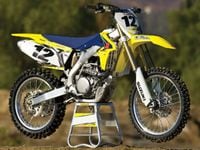

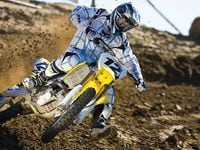
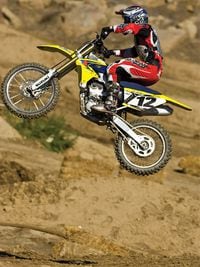
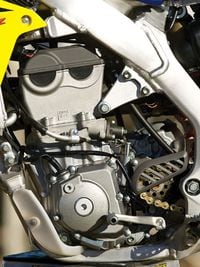
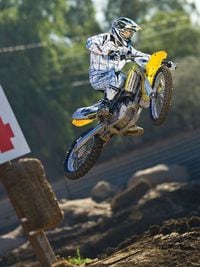
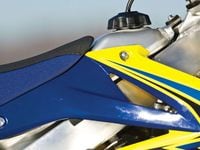
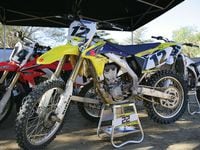
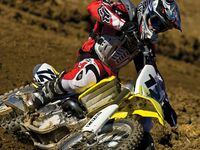
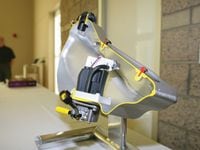
/cloudfront-us-east-1.images.arcpublishing.com/octane/SQ3CEIVCOJF7FDERDVDKKPIC7A.jpg)
/cloudfront-us-east-1.images.arcpublishing.com/octane/LLLQLRK2DBH4PN66MDNA3AFJNY.jpg)
/cloudfront-us-east-1.images.arcpublishing.com/octane/5DMU4K752FBWLLJD432GRAAH2A.jpg)
/cloudfront-us-east-1.images.arcpublishing.com/octane/TGHDVMIODJC4BNKJDZKKTSWXWI.jpg)
/cloudfront-us-east-1.images.arcpublishing.com/octane/5KYMT24REJEFPNO2J2M76MXERM.jpg)
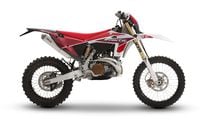
/cloudfront-us-east-1.images.arcpublishing.com/octane/3GXGR3EKSNH5NI3CWHV5SJ7TXE.jpg)
/cloudfront-us-east-1.images.arcpublishing.com/octane/JEU3ONDWEFCAZNAZJOU24OJ2PM.jpg)
/cloudfront-us-east-1.images.arcpublishing.com/octane/JQ6LMK6LLBAQJIL2AH56UIUKWU.jpg)
/cloudfront-us-east-1.images.arcpublishing.com/octane/QUSF4LLRM5DDPCJW25RINQRJPE.jpg)
/cloudfront-us-east-1.images.arcpublishing.com/octane/FYDGK7GF4JBPXERA5RAZPY3YJI.jpg)
/cloudfront-us-east-1.images.arcpublishing.com/octane/JE7KMNASNRGR7FLYAFRZAR7T7E.jpg)
/cloudfront-us-east-1.images.arcpublishing.com/octane/7RCNKJJNXBF4LBKZXE2INNWZUY.jpg)
/cloudfront-us-east-1.images.arcpublishing.com/octane/BAGM5E4EWBHFNLZOXMSLOLKQGU.jpg)
/cloudfront-us-east-1.images.arcpublishing.com/octane/RSX65VBXY5FRLIY4LN6WLOKAFM.jpg)
/cloudfront-us-east-1.images.arcpublishing.com/octane/3EO2CNKWUFBGNMGNJPETW5HCNY.jpg)
/cloudfront-us-east-1.images.arcpublishing.com/octane/IYHM55XRNVHF3DSS3467PZ7ONQ.jpg)
/cloudfront-us-east-1.images.arcpublishing.com/octane/L7K3FIINEBHMZI2TXTUE4FXH7I.jpg)
/cloudfront-us-east-1.images.arcpublishing.com/octane/XE7P5YXNZZDUTIGW4YNWQRDVY4.jpg)
/cloudfront-us-east-1.images.arcpublishing.com/octane/AV55DOHQ3BEXJLPWR6UWLYUSAQ.jpg)
/cloudfront-us-east-1.images.arcpublishing.com/octane/MMROGOYHXZAYDC4RKIDJ4VRSGA.jpg)
/cloudfront-us-east-1.images.arcpublishing.com/octane/FHRWLPEOTBFOHFTQLIHJNIXCFQ.jpg)
/cloudfront-us-east-1.images.arcpublishing.com/octane/J2RUDOXTOZHBXOFCUQKBAGBMAQ.jpg)
/cloudfront-us-east-1.images.arcpublishing.com/octane/UDQASRGJ3ZDG3BANXWU6P5NIQY.jpg)